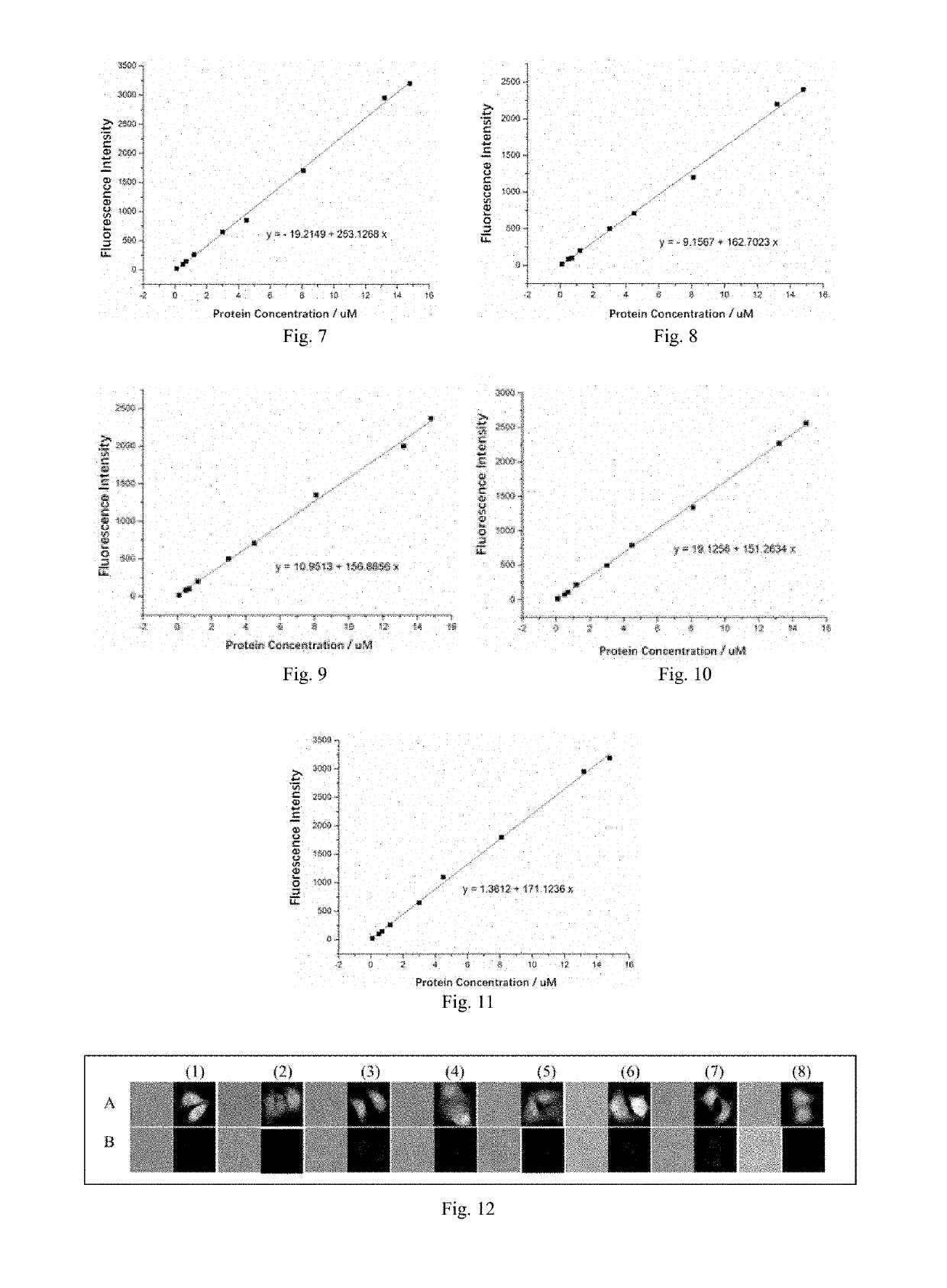Fluorescent probe and preparation method and use thereof
a fluorescent protein and probe technology, applied in the field of fluorescence probes, can solve the problems of long maturation and folding time of fluorescent proteins, difficult post-modification construction of different types or functionalized fluorescent proteins, and difficulty in rapid quantitative detection of target proteins, etc., to achieve rapid contrast imaging and quantitative detection
- Summary
- Abstract
- Description
- Claims
- Application Information
AI Technical Summary
Benefits of technology
Problems solved by technology
Method used
Image
Examples
example 1
[0097]A fluorescence-activated covalently labeling fluorescent probe 1 for SNAP protein tags was constructed using a molecular rotor as a viscosity-sensitive fluorescent dye.
Compound 1
[0098]To a solution of N-methyl-N-(2-hydroxyethyl)-4-amino-benzaldehyde (0.358 g, 2 mmol) and tert-butyl cyanoacetate (0.338 g, 2.4 mmol) in 50 mL anhydrous ethanol, a catalytic amount of anhydrous zinc chloride was added. The obtained mixture was heated in an oil bath for 5 hrs under the protection of Ar. After the reaction was completed, the solution was cooled at room temperature, a part of the solvent was removed by rotary evaporation. A large amount of precipitate was formed. The precipitate was separated by filtration, thoroughly washed with cooled ethanol twice and finally dried in vacuo to give a pure yellow compound 1 (0.49 g, 81%). 1H-NMR (400 MHz, DMSO-d6): δ=8.01 (s, 1H), 7.97 (d, 2H, J=9.2 Hz), 6.85 (d, 2H, J=9.2 Hz), 4.79 (bt, 1H), 3.55-3.59 (m, 4H), 3.08 (s, 3H), 1.50 (s, 9H).
Compound 2
[...
example 2
[0101]A fluorescence-activated covalently labeling fluorescent probe 2 for SNAP protein tags was constructed using a molecular rotor as a viscosity-sensitive fluorescent dye.
Compound 3
[0102]The synthesis was carried out with reference to the method disclosed in J. Das et. al. Bioorg. Med. Chem. Lett. 2005, 15, 337-343. 1H-NMR (400 MHz, CDCl3): δ=7.74 (d, 1H, J=4.0 Hz), 7.55 (d, 1H, J=4.0 Hz), 7.36-7.42 (m, 2H), 4.12 (s, 2H).
Compound 4
[0103]This compound was obtained by following the general procedure for compound 1. 1H-NMR (400 MHz, DMSO-d6): δ=8.11-8.07 (m, 2H), 8.01-7.97 (m, 3H), 7.70 (d, 1H, J=8.8 Hz), 7.46-7.43 (m, 1H), 6.27 (dd, 1H, J=9.2, 1.6 Hz), 6.02 (s, 1H), 3.88 (t, 2H, J=5.6 Hz), 3.64 (t, 2H, J=5.6 Hz), 3.15 (s, 3H).
Probe 2
[0104]This probe was obtained by following the general procedure for probe 1, and the yield was 75%. 1H-NMR (400 MHz, DMSO-d6): δ=12.41 (s, 1H), 10.01 (s, 1H), 8.11-8.07 (m, 2H), 8.01-7.97 (m, 3H), 7.81 (s, 1H), 7.70 (d, 1H, J=8.8 Hz), 7.46-7.43 (m, 1H)...
example 3
[0105]A fluorescence-activated covalently labeling fluorescent probe 3 for SNAP protein tags was constructed using a molecular rotor as a viscosity-sensitive fluorescent dye.
Compound 5
[0106]This compound was obtained by following the general procedure for compound 1, and the yield was 95%. 1H-NMR (400 MHz, CDCl3): δ=8.09 (s, 1H), 8.02 (d, 1H, J=8.0 Hz), 7.98 (d, 2H, J=9.2 Hz), 7.86 (d, 1H, J=8.4 Hz), 7.48 (t, 1H, J=7.8 Hz), 7.36 (t, 1H, J=7.36 Hz), 6.73 (d, 2H, J=9.2 Hz), 3.88 (t, 2H, J=5.6 Hz), 3.64 (t, 2H, J=5.6 Hz), 3.15 (s, 3H).
Probe 3
[0107]This probe was obtained by following the general procedure for probe 1, and the yield was 65%. 1H-NMR (400 MHz, DMSO-d6): δ=12.40 (s, 1H), 10.02 (s, 1H), 8.09 (s, 1H), 8.02 (d, 1H, J=8.0 Hz), 7.98 (d, 2H, J=9.2 Hz), 7.86 (d, 1H, J=8.4 Hz), 7.81 (s, 1H), 7.48 (t, 1H, J=7.8 Hz), 7.40 (m, 4H), 7.36 (t, 1H, J=7.36 Hz), 6.73 (d, 2H, J=9.2 Hz), 6.29 (s, 2H), 5.46 (s, 2H), 4.40 (d, 1H, J=4.8 Hz), 3.88 (t, 2H, J=5.6 Hz), 3.64 (t, 2H, J=5.6 Hz), 3.15 ...
PUM
 Login to View More
Login to View More Abstract
Description
Claims
Application Information
 Login to View More
Login to View More - R&D
- Intellectual Property
- Life Sciences
- Materials
- Tech Scout
- Unparalleled Data Quality
- Higher Quality Content
- 60% Fewer Hallucinations
Browse by: Latest US Patents, China's latest patents, Technical Efficacy Thesaurus, Application Domain, Technology Topic, Popular Technical Reports.
© 2025 PatSnap. All rights reserved.Legal|Privacy policy|Modern Slavery Act Transparency Statement|Sitemap|About US| Contact US: help@patsnap.com



